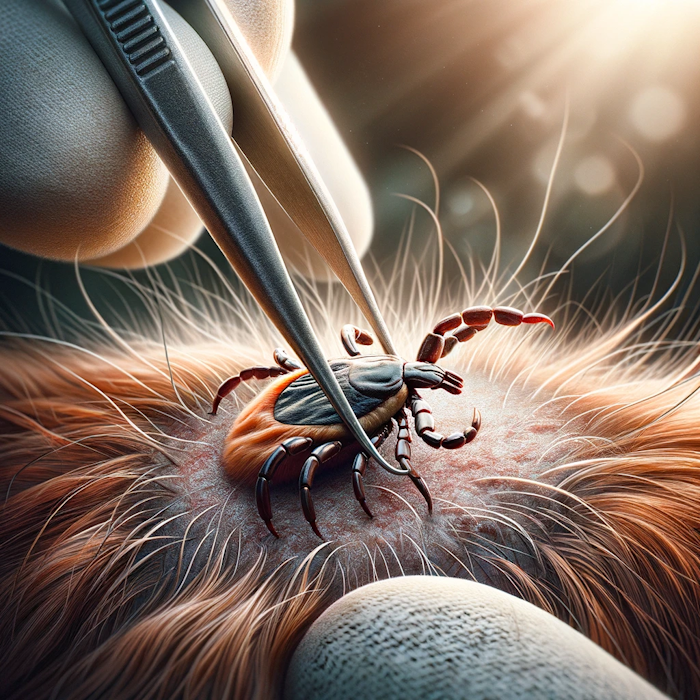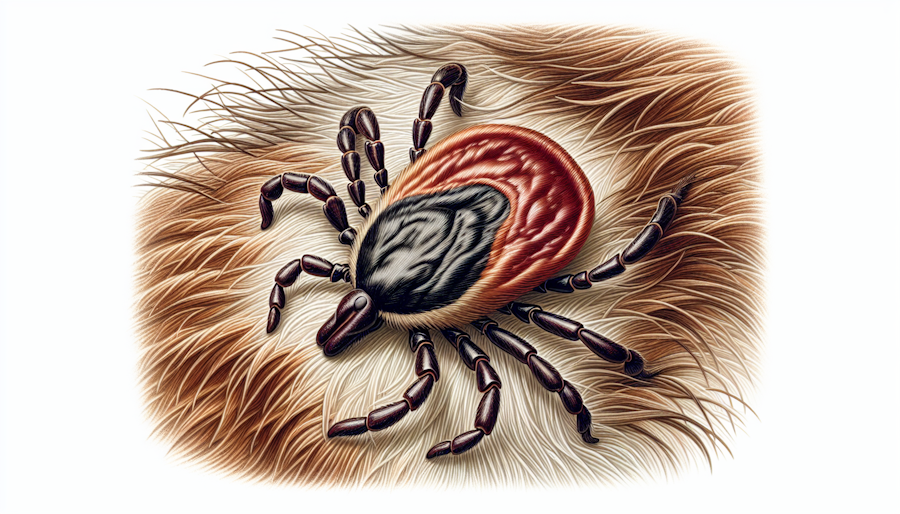With warm weather just around the corner in Philadelphia, dog owners might find themselves needing to remove a tick from their dog’s fur. Our expert guide gives you direct, easy-to-follow steps to quickly and safely extract ticks and protect your pet’s health.
Key Takeaways
- A thorough daily inspection of a dog’s skin and fur, especially in warm concealed areas, is crucial for early detection and identification of ticks, differing them from harmless skin tags or scabs.
- A calm approach using the right tools like fine-tipped tweezers or a tick removal hook is essential for successfully removing a tick without crushing it and risking infection.
- Post-removal, it’s important to disinfect the bite area and monitor the dog for symptoms of tick-borne diseases. At the same time, prevention involves regular checks and the use of flea and tick preventatives.
Identifying a Tick on Your Dog
Spotting a tick, such as an American dog tick, on your dog can be as challenging as finding a needle in a haystack, especially when they’re as small as a pinhead and expertly camouflaged in your pet’s fur. Yet, with a keen eye, you can identify these critters by their distinct features:
- Oval shape
- Large abdomen
- Small head
- Eight purposeful legs
Unlike the harmless skin tag or a healing scab, a tick is a miniature vampire, growing greedily as it feeds on your dog’s blood through a tick bite, revealing its presence through subtle leg movements.
But where should you search for these unwelcome guests? Ticks are masters of hide-and-seek, preferring the warm seclusion of areas such as between your dog’s toes, inside the ears, the base of the tail, and around the neck and face. It’s in these cozy nooks that ticks thrive undetected, making daily inspections a crucial part of your pet care routine. By feeling for bumps or inspecting for swelling, you might just intercept a tick before it can cause any harm.
Preparing for Tick Removal
Before diving into the tick removal process, we recommend setting the stage for a success extraction. The calmer your canine, the smoother the operation will be. Whether it’s a soothing voice or their favorite treat, ensuring your dog is at ease can make all the difference.
Now, what’s a craftsperson without their tools? Arm yourself with fine-tipped tweezers or a specialized tick removal hook to tackle the task at hand. These tick removal tools are designed to evict ticks efficiently, with the tick removal hook simplifying the process by sliding easily under the unwelcome occupant.
Ready the stage, gather your courage, and with tools in hand, you’re set to confront the tick. Remember, patience is your ally, and precision is your weapon. As you prepare to reclaim your pet’s skin from these tiny trespassers, keep in mind that the right approach can spare both you and your pet unnecessary stress.
Step-by-Step Tick Extraction


Spotting a tick on your dog can be as challenging as finding a needle in a haystack, especially when they’re as small as a pinhead and expertly camouflaged in your pet’s fur. Yet, with a keen eye, you can identify these critters by their distinct features:
- Oval shape
- Large abdomen
- Small head
- Eight purposeful legs
Unlike the harmless skin tag or a healing scab, a tick is a miniature vampire, growing greedily as it feeds on your dog’s blood through a tick bite, revealing its presence through subtle leg movements.
But where should you search for these unwelcome guests? Ticks are masters of hide-and-seek, preferring the warm seclusion of areas such as between your dog’s toes, inside the ears, and around the neck and face. It’s in these cozy nooks that ticks thrive undetected, making daily inspections a crucial part of your pet care routine. By feeling for bumps or inspecting for swelling, you might just intercept a tick before it can cause any harm.
Preparing for Tick Removal
Before diving into the tick removal process, it’s essential to set the stage for success. The calmer your canine, the smoother the operation will be. Whether it’s a soothing voice or their favorite treat, ensuring your dog is at ease can make all the difference.
Now, what’s a craftsperson without their tools? Arm yourself with fine-tipped tweezers or a specialized tick removal hook to tackle the task at hand. These tick removal tools are designed to evict ticks efficiently, with the tick removal hook simplifying the process by sliding easily under the unwelcome occupant.
Ready the stage, gather your courage, and with tools in hand, you’re set to confront the tick. Remember, patience is your ally, and precision is your weapon. As you prepare to reclaim your pet’s skin from these tiny trespassers, keep in mind that the right approach can spare both you and your pet unnecessary stress.
Step-by-Step Tick Extraction
Embarking on the tick extraction journey requires a steady hand and a clear plan. The mission: to detach the tick in its entirety, leaving no trace behind in your dog’s skin. It’s a delicate dance, one that involves grasping the tick close to the skin, lifting it away with care, and thoroughly checking the extraction site.
With each step meticulously followed, the success of the tick removal process is within reach, ensuring you can effectively remove ticks and remove a tick, including properly removing ticks.
Grasping the Tick
When it comes to removing a tick, precision is paramount. Equip yourself with fine-point tweezers, the tick remover of choice for this delicate task. Approach with confidence, parting your dog’s fur to reveal the tiny intruder. With a gentle yet firm grip, use the tweezers to grasp the tick as close to the skin surface as possible, avoiding the tick’s body to prevent the spread of any infections.
Envision yourself as a surgeon in the operating room; your fingers slowly close on the tweezers, securing the tick without squeezing its abdomen. This careful approach is crucial, as a crushed tick can release harmful pathogens into your dog’s bloodstream. Now, with the tick firmly in your grasp, you’re ready for the critical next step—removal.
Lifting the Tick Away
The moment of truth has arrived—it’s time to lift the tick away from its feeding ground. Here’s how to do it:
- Position the tick removal tool so that it’s snug against your dog’s skin, just adjacent to the tick’s stubborn hold.
- Slide the remover under the tick’s body, ensuring it’s primed for a clean departure.
- With a calm and steady motion, elevate the tick upwards, as if it’s on an elevator to freedom, leaving no room for twisting or squeezing that could risk leaving behind any part of the tick’s mouth.
Imagine the tick as an anchor, and you’re setting sail for clearer seas. Pull directly upward, and feel the satisfaction as the tick relinquishes its grip. Your dog’s skin is now free from the clutches of this unwelcome stowaway, thanks to your careful execution of the removal process.
Checking the Extraction Site
Inspect the area with the scrutiny of a detective, searching for any remnants that could spell trouble for your furry friend. Should you spot the tick’s head or mouthparts still embedded, it’s a red flag signaling the need for additional care. A clear site is the hallmark of a successful tick removal, with no villainous parts left to lurk in the skin.
If you do encounter any leftover pieces, sterilized tweezers are your go-to tool for their careful extraction. Approach the site with the same precision as before, removing any remnants to prevent infection and ensure complete healing. Once the coast is clear, you can breathe a sigh of relief, knowing your tick extraction mission is accomplished.
Post-Removal Care
After the tick’s eviction, the post-removal care begins. Think of it as a cleaning crew sweeping in after a storm, ensuring everything is back in order. Start by disinfecting the bite area with rubbing alcohol, or opt for a gentler cleaning solution if your dog’s skin is sensitive. Next, give the tick a one-way ticket to oblivion by submerging it in a sealed container filled with isopropyl alcohol. This not only ensures the tick meets its end but also preserves it in case your vet needs to make an identification later.
Don’t forget about your own hands and your dog’s fur, which may have come into contact with the tick. Wash thoroughly to remove any potential pathogens lingering from the encounter. With the bite area clean and the tick disposed of, you’ve taken a significant step towards safeguarding your pet’s well-being.
Monitoring for Tick-Borne Diseases
Even after a tick, such as the lone star tick, has been successfully removed, the shadow of tick-borne diseases remains. These diseases, such as Lyme disease and Canine Granulocytic Ehrlichiosis, are stealthy adversaries, manifesting through symptoms like fever and joint swelling. Ticks can transmit diseases like Anaplasmosis, another tick-borne villain, which can bring about lethargy and joint stiffness, or in severe cases, even neurological issues. It’s imperative to keep a watchful eye on your dog for any changes in behavior, appetite, or energy levels that may indicate disease.
Should your dog exhibit any concerning symptoms post-tick removal, or if your gut instinct sets off alarm bells, don’t hesitate to consult your veterinarian. With their expertise, they may recommend tests such as the annual 4dx screening to assess for exposure to different diseases and ensure your dog’s continued health.
Preventing Future Tick Bites
As the saying goes, “an ounce of prevention is worth a pound of cure.” Regular tick checks should become as habitual as your daily walks, especially if your dog is an outdoor enthusiast. These checks are a year-round necessity, as ticks can remain active even in colder months. And let’s not forget the power of preventative measures. Consistent application of flea and tick preventatives, such as Frontline Plus or Seresto collars, can fortify your dog against future invaders. Additionally, vaccines against Lyme disease provide an extra layer of armor, though it’s important to note that vaccines for Ehrlichiosis and Anaplasmosis are not yet available.
Encircle your calendar, set reminders, and make tick prevention a non-negotiable part of your pet care routine. By staying vigilant and proactive, you can prevent tick bites, minimize the risk of tick bites, and keep your dog prancing happily in the sun, free from the worry of a tick from your dog.

